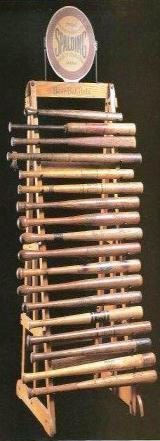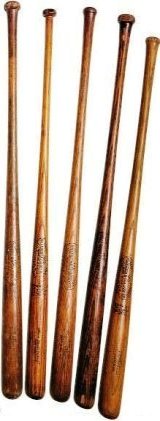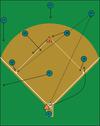Relay and cutoff responsibilities
by Lou
(Bronx, New York)
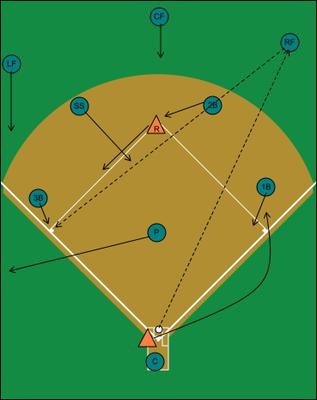
Runner on second, fly ball to right field
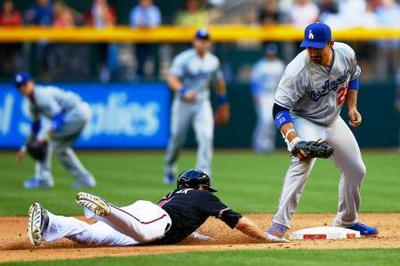
Double cutoff run to perfection to back pick a base runner
Lou asked: With all the different relay and cutoff situations, how can coaches and young players remember all of the player responsibilities?
Example: Player responsibilities can change on a fly ball to right field, with runner on second, if right fielder drops ball.
Should first baseman immediately run to cutoff position, or shortstop stay with cutoff because he assumed right fielder would catch baseball?
Rick answered: Lou, thank you for your question.
It sometimes can seem overwhelming. How is it possible to cover all the material there is, let alone have the time to effectively work on each item?
On the site is a page,baseball practice organization, which may provide you with some ways to organize all there is to work on.
Within this segment, lets look at the relay situation you described in your question, "a runner on second, fly ball to right field. We'll work through less than two outs, and two outs.
First, less than two outs. As you look at the diagram above, every player has a place they need to be moving to.
This is initially one of the harder concepts to get players to do. You will find that the further away a player is from the immediate action, the more likely they are to remain stationary.
Back to the fly ball. Off the bat, the runner on second will be tagging up, the batter-runner is out of the box and running for first base, looking to round the bag in the possibility that the ball is not caught.
Defensively, everyone except the catcher is on their way to another spot on the field.
The third baseman goes to 3B in case the runner from second tags and runs on the catch, or the ball is not caught.
Shortstop gets in line to be the cutoff/relay to 3B, in case the runner goes.
Second baseman comes to second base, I have the first baseman come down inside the first base bag, out of the baseline. I do that to provide the batter-runner a visual of someone standing there, which may cause them to turn a little wider. Should he end up trying to go to 2B, it may make a play there a little closer.
Left fielder is headed to back up 3B, center fielder is coming towards second base, in case of a play there resulting in a bad throw.
Pitcher heads to back up third base, getting as deep behind the base as possible, in case of a bad throw there.
Right fielder calls for the ball, and hopefully makes the catch. If so, his relay throw is directly to and through the SS. If the runner goes, depending on the throw, the SS lets it go, or cuts it off.
If the RF drops the ball, the runner will be gone from 2B, and you are looking to keep him from scoring.
The 1B comes further inside the infield and sets up as the cutoff to the plate. Once the pitcher sees the fly ball is dropped, he moves to backup home plate, the RF is throwing to and through the first baseman at that point.
With two outs, the runner on second is running when the ball is hit. He will most likely score on the drop, RF is throwing to 2B, to keep the batter-runner at 1B.
When you put it down on paper, it seems much more daunting than it is.
How do you, and the players, remember all of the situations.
There is a drill called game situation fungos. As a player, we did this drill constantly from Little League, high school, college and 38 years coaching. A valuable tool, players like it.
With this drill you are able to create any and all situations they may encounter. You have 9 players on the field at a time, the extra players are base runners. Rotate players in and out as you want. This is a great drill to provide players with experience at playing all positions on the field. The more versatile a player is, the more valuable he will be for all the teams he will play for in the future.
With your cutoffs and relays, I would start very basic, single cuts on base hits, no runners, gradually increase it to 1 runner, then 2, then 3.
Players won't derive much, if any benefit from a diagram. Use the field as your paper, describe the situation, then walk them through where they go to, and explain why they go there every time, not just when it looks like there will be a play.
The reality of defensive baseball is you, as a player, may sprint to a spot in a given situation 300 times in a season, so that you are there for that one time the ball gets away.
In high school I was a third baseman. We had a drill where coaches hit a ground ball back to the pitcher who was to field it and either work on the DP, or no runner and throw to first.
As a 3B, we were in on every ground ball hit back to the mound. Our job was to crash the mound, in the event the ball went off the pitcher in our direction. Over 4 years of high school and four years of college I only had to make that play twice, but the one time in college it was the difference in our getting into the regional tournament.
It only works if you go every time, full out, so you are in position. It is harder to get outfielders to anticipate where they need to be when the ball is hit, rather than moving after the throw is in the air. If you go slow, walk through, then do it live, with runners they will learn it. Eventually it becomes second nature.
It's a good feeling when you see them do it in practice; but the best feeling of all is to see them make it happen in an actual game. They have learned to think on their feet and there is truly nothing better to watch than a team that all functions as one entity.
The second picture above is the end result of a double cut which was set up to go to 3B.
The blurry Dodger outfielder in the background is the outfielder who retrieved the extra base hit.
The next tow coming back towards the infield are the SS and 2B. It looks like the SS, who was the lead infielder out, cut the ball and threw back to 2B to the 1B who had trailed the batter-runner on the play.
When the runner decided not to try for 3B, the Dodgers back picked him.
That is a double cutoff, modified on the run, and done to perfection.
Below are some site links which may provide some additional information you may find helpful.
Good luck as you move forward.
Yours in baseball,
Rick
Baseball Practice Organization
Coaching Confidence
Baseball Skills Checklist
There are times when you begin to wonder if they are ever going to get it, and then from out of nowhere, there it is. Once they have made it happen, they will continue to repeat it.

